Sustainability: food, people & planet
Also see: Fire, Emergency & Rescue articles (various)
EVENTS & MARKETS
WORKSHOPS & ONE-DAY EVENTS:
- Submit your event
SUMMER MARKETS (West Shore area, Vancouver Island):
- ONGOING May to October – Sooke Country Market, Otter Pt Rd at Eustace (Sooke town centre). Saturdays, 10 am to 2 pm.
- ONGOING May 13 to October 21 – Goldstream Farmers Market at Veterans Memorial Park, Langford. Saturdays, 10 am to 2 pm
- ONGOING May 13 to October 28 – Metchosin Farmer’s Market – Sundays 11 am to 2 pm. 4450 Happy Valley Rd behind Metchosin fire hall.
- ONGOING. End of May to end of September – Shirley’s Farmers Market. Sundays 10:30am to 3:30pm, Shirley Community Hall’s Pioneer Park, 20 km NW of Sooke on West Coast Road (Hwy 14).
NEWS
Wednesday, August 29 ~ BC. BC’s wildfire-driven provincial state of emergency as first declared August 15 has been formally extended by 14 days, through the end of the day on Wednesday September 12, 2018. It may be further extended or rescinded as necessary. It applies to the entire province.
This ensures that all needed resources can be delivered in a coordinated response to the wildfire situation and continue to ensure public safety, which remains the provincial government’s top priority.
As of this morning, 534 wildfires are burning in BC (was at 526 a week ago), with 34 evacuation orders affecting approximately 3,200 people, plus 53 evacuation alerts impacting approximately 21,800 people.
The Province’s decision to extend the provincial state of emergency will support the significant number of people who remain under evacuation orders and alerts. The state of emergency gives agencies, such as Emergency Management BC, the fire commissioner, the Ministry of Forests, Lands, Natural Resource Operations and Rural Development, and the RCMP, the authority to take every action necessary to fight the wildfires and protect residents and their communities.
Thursday, August 23 ~ VICTORIA. Prior Lake Tests Positive for Blue-Green Algae – The Capital Regional District (CRD) advises that water samples taken from Prior Lake, located at the north end of Thetis Lake Regional Park, have tested positive for a type of blue-green algae that produces cyanotoxins. Visitors are advised to avoid swimming at Prior Lake and to keep animals on a leash to prevent them from drinking or swimming in the lake until the advisory has been lifted.
The algae usually produce a visible blue-green sheen, which appears as surface scum. Not all blooms are easy to see and toxins can still be present in the water even if you cannot see the blooms. Blooms are unpredictable and may occur at any time.
These algae are known toxin producers and these compounds have been detected previously at Thetis Lake. Ingesting water containing these cyanotoxins may cause a range of symptoms, including headaches and abdominal pain in humans, and can lead to lethal liver damage in dogs.
There are no signs of blue-green algae at Upper or Lower Thetis Lake.
Updates on the algae bloom: www.crd.bc.ca/alerts | Twitter: @crd_bc
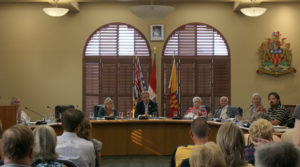
There are many reasons to get the wildfires under control sooner. In the last few days especially, the continued risk to human health from high-risk levels of smoke in the air throughout most of BC has become more evident. People are more frequently staying indoors to avoid direct exposure. Costs are rising for increased use of air conditioners and other equipment for staying cool. Economic impacts include people cancelling events, appointments, or even going to work.
Extended wildfire seasons are now “the new normal” as BC Premier John Horgan said today at a media event in Prince George in the BC Interior.
Premier Horgan said that the safety of people comes first, and that people who receive evacuation orders need to follow those directives as a way for themselves to stay safe as well the firefighters and the surrounding community areas.
See full article here, including video of the firefighter bomber.
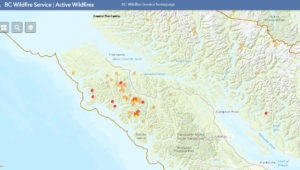
If a wildfire is especially visible or poses a threat to public safety, the BC Wildfire Service classifies it as a “Wildfire of Note” and provides detailed updates as information becomes available.
On northwest Vancouver Island, there are fires of note at Pinder Creek & Zeballos. Link to wildfires of note available on this page: https://www2.gov.bc.ca/gov/content/safety/wildfire-status/wildfire-situation
“I’ve never seen that many at one time and over such an area,” said Kevin Skrepnek, Chief Fire Information Officer, BC Wildfire Service, today during a media conference. Just today, there are 14 new fires.
Fires on Vancouver Island are in the northwest area of the island. Smoky skies have been evident throughout BC, and into Alberta.
Read the full article here: https://islandsocialtrends.ca/?page_id=12909
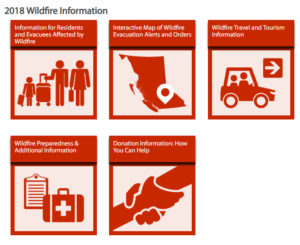 Wednesday, August 15 ~ BC. [Text of BC News release, August 15, 2018]. The British Columbia government has declared a provincial state of emergency to support the province-wide response to the ongoing wildfire situation. [Wildfire information at Emergency Info BC: https://www.emergencyinfobc.gov.bc.ca ]
Wednesday, August 15 ~ BC. [Text of BC News release, August 15, 2018]. The British Columbia government has declared a provincial state of emergency to support the province-wide response to the ongoing wildfire situation. [Wildfire information at Emergency Info BC: https://www.emergencyinfobc.gov.bc.ca ]
Mike Farnworth, Minister of Public Safety and Solicitor General, made the declaration based on the recommendation from BC’s wildfire and emergency management officials.
The state of emergency is initially in effect for 14 days, once issued, and may be extended or rescinded as necessary. The state of emergency applies to the whole province and ensures federal, provincial and local resources can be delivered in a coordinated response to protect the public, which remains the provincial government’s top priority.
“Public safety is always our first priority and, as wildfire activity is expected to increase, this is a progressive step in our wildfire response to make sure British Columbia has access to any and all resources necessary,” Farnworth said. “Taking this step will further ensure we can protect the public, property and infrastructure, and assist with firefighting efforts.”
As of August 14, there were 566 wildfires burning in BC, with 29 evacuation orders affecting approximately 3,050 people (1,521 properties), in addition to 48 evacuation alerts impacting approximately 18,720 people (9,359 properties).
The extended weather forecast calls for continued hot and dry conditions, with risk of thunderstorms in some parts of the province.
Currently, more than 3,372 firefighters and contractors are actively engaged in fighting fires in all fire regions of the province. This includes 1,427 BC contract personnel, as well as 436 out-of-province personnel from Alberta, New Brunswick, Northwest Territories, Quebec, Saskatchewan, Parks Canada, Australia, Mexico and New Zealand.
The federal government has responded to and accepted British Columbia’s request for assistance. In the coming days, federal personnel and resources will be arriving in BC to assist with wildfire efforts.
“Given the unpredictable behaviour of wildfires and the number of significant wildfires in all areas of the province, we’re bringing in the additional resources we need to keep people and communities as safe as possible,” said Doug Donaldson, Minister of Forests, Lands, Natural Resource Operations and Rural Development. “We’re asking British Columbians to do their part and follow burning bans and restrictions to prevent human-caused fires.”
The state of emergency gives agencies, such as the Ministry of Forests, Lands, Natural Resource Operations and Rural Development, Emergency Management BC, the fire commissioner and the RCMP, the authority to take every action necessary to fight the wildfires and protect people and communities.
Declarations of provincial states of emergency may be issued by the minister responsible under the Emergency Program Act. The provincial government can extend the period of a declaration made by the minister responsible, for further periods of time. During the 2017 wildfire season, the Province was in a provincial state of emergency for 10 weeks, from July 7 to September 15.
The last provincial declaration of state of emergency before the 2017 wildfire season was issued in August 2003, to deal with wildfires.

That’s listed as ‘moderate risk’ (at the top of the 4 to 6 range), though yesterday health officials were calling the smoke levels ‘high risk’. The forecast shows the Air Quality Health Index could reach 7 (7 to 10 is officially High Risk) in the next 18 hours.
Seniors, young children, and anyone with lung, heart or chronic health disorders can find breathing to be more difficult when the air quality is poor. Reducing strenuous activities outdoors is applicable to everyone under these conditions.
The smoky skies are a result of wildfires burning in north-central BC and on Vancouver Island. A ridge of high pressure is preventing the dispersal of the smoke from the south-island region.
The smoke may contain some degree of chemicals from the fire retardants used to battle the wildfires.
According to the BC Ministry of Forests, Lands, Natural Resource Operations and Rural Development, fire retardants, foam and water can all be used to slow down a fire’s growth. They support the efforts of ground crews in containing the fire. Water-soluble fire retardants are commonly used in fire suppression because of their long-lasting effect on fires. They contain ammonium salts which affect the burning process of forest fuels. The fire retardant liquid concentrate is mixed with water at a ratio of 5.5 parts water to one part concentrate to form the working solution. Retardant has a much longer-lasting effect than water in fire suppression because it does not evaporate. On average, about 9.4 million litres of fire retardant is used each fire season in BC.
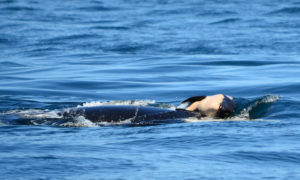
When I think of the 17 days of the ‘tour of grief’ exhibited by the endangered female orca known as J35, I can’t help but think this was done as a very public way of saying “look at what you’ve done you ignorant humans!”
Over-fishing, pollution, plastics, blasting, jet rumblings, ferries, freighters, cruise ships, underwater interference from submarines, military exercises, global warming, …do we need more proof like this to demonstrate that we are causing death and destruction to our natural world?
We’ve been blessed with a utopia of natural beauty, splendor and abundance. Solutions exist to ensure it survives, but it doesn’t appear we are learning and listening! I highly recommend viewing the animated video, #WakeUpCall, by the Gaia Foundation and being part of the solution by joining one of the many organizations listed at www.creativelyunited.org
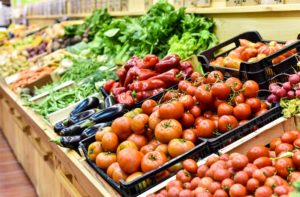 Tuesday, July 31 ~ BC. September deadline approaching for organic food and beverage certification.
Tuesday, July 31 ~ BC. September deadline approaching for organic food and beverage certification.
Producers are reminded that in one month, a new, strengthened regulatory approach for domestically marketed organic food and beverage products will be in place in British Columbia.
Beginning September 1, 2018 the BC government is regulating the term “organic.” This means food and beverage products marketed in British Columbia as “organic” will be required to be certified through an accredited federal or provincial program.
The modern system will provide consumers with confidence that the BC organic agriculture products they enjoy will be backed up with standards and requirements for the key words and phrases used to describe and market them.
Uncertified producers in the province marketing their food or beverage products as “organic” will face the possibility of penalties, including a $350 fine.
The new regulations were originally announced in 2016. Non-certified producers have been provided with a lengthy transition period to September 2018 to allow the time to complete the certification process.
Further information on BC’s organic food and beverages and amendments to the current provincial regulation: https://www2.gov.bc.ca/gov/content/industry/agriculture-seafood/animals-and-crops/organic-food-and-beverages
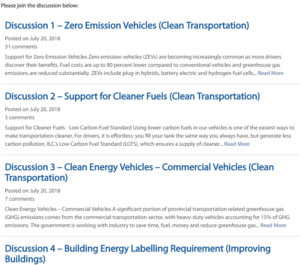 Monday, July 23 ~ BC. BC seeks public comment on clean growth
Monday, July 23 ~ BC. BC seeks public comment on clean growth
BC is developing a long-term clean growth strategy for release in Fall 2018. Public comments can be made on eight discussion papers https://engage.gov.bc.ca/cleangrowthfuture/ . This style of public engagement is not in survey format with pre-set questions. Comments must be composed by the participant, with name and email address required (region and age indicators optional).
The Ministry of Environment and Climate Change Strategy said July 20 that the new clean growth strategy (CGS) will bring together BC’s action on climate change. Work is underway on BC’s energy roadmap to drive sustainable economic growth with cleaner energy and fewer emissions.
The CGS will be integrated with the province’s Economic Development Strategy, #BCTech Strategy and Emerging Economy Task Force and will set out a vision for a clean growth future and a pathway to greenhouse gas (GHG) emission reduction targets. The plan will be expanded as new opportunities arise, with further public input opportunities on priority areas.
The first set of intentions papers covers proposed actions in three key areas – transportation, buildings, and clean growth for industry. The intentions papers are available for comment for the next five weeks — from July 20 to 4pm on August 24, 2018. Individuals and organizations may send additional information by to clean.growth@gov.bc.ca by August 24, 2018.
Written submissions meeting the posting criteria will be posted publicly and online comments will be summarized in a final report.
Priority areas for comment have been recommended by BC’s Climate Solutions and Clean Growth Advisory Council: Zero Emission Vehicles (Clean Transportation); Support for Cleaner Fuels (Clean Transportation); Clean Energy Vehicles – Commercial Vehicles (Clean Transportation); Building Energy Labelling Requirement (Improving Buildings); Financial Incentives (Improving Buildings); Stronger Codes and Standards (Improving Buildings); Low Carbon Buildings Innovation Program (Improving Buildings); Training and Certification (Improving Buildings).
 Friday, July 20 ~ EDITORIAL. Picking on plastic straws.
Friday, July 20 ~ EDITORIAL. Picking on plastic straws.
Banning plastic straws is an easy and relatively non-controversial place to start for almost anyone who wants to contribute to cleaning up the environment. [See full editorial]
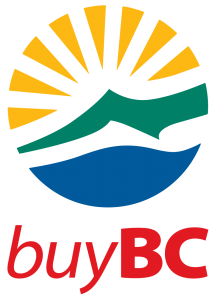 Saturday, June 23 ~ BC. Buy BC programming is being relaunched to boost BC’s agriculture industry and fuel public interest in shopping for made-in-BC products.
Saturday, June 23 ~ BC. Buy BC programming is being relaunched to boost BC’s agriculture industry and fuel public interest in shopping for made-in-BC products.
Buy BC marketing had been cancelled in the early 2000s, but will again make it easier for British Columbians to explore new and different products from around the province, said BC Agriculture Minister Lana Popham at a farmer’s market in Victoria, June 23.
Buy BC will introduce BC-produced food and drink in BC and globally, said Popham. Cost-shared funding is available to agriculture and seafood producers, processors and co-operatives, as well as relevant industry associations, plus local agricultural fairs and markets.
Logo-licencing agreements will be available for BC agriculture and seafood companies that do not require cost-shared funding, but who use the Buy BC logo on products.
Local food is sold at over 145 community farmers’ markets across the province, says the BC Association of Farmers’ Markets.
The Buy BC Partnership Program will provide $2 million per year, over the next three years, to help eligible applicants with marketing using the Buy BC logo on their products or promotional materials. The program will be administered and delivered by the Investment Agriculture Foundation of BC, with the support of the Ministry of Agriculture.
 Tuesday, June 5 ~ NATIONAL. Canada continues to provide international leadership to address climate change, honour its Paris Agreement commitments, and transition to a low-carbon, clean-growth economy. We know our future prosperity and well-being depend on taking ambitious, coordinated action at home and as a global community.
Tuesday, June 5 ~ NATIONAL. Canada continues to provide international leadership to address climate change, honour its Paris Agreement commitments, and transition to a low-carbon, clean-growth economy. We know our future prosperity and well-being depend on taking ambitious, coordinated action at home and as a global community.
Today, on World Environment Day, the Prime Minister, Justin Trudeau, announced that Patricia Fuller has been appointed Canada’s new Ambassador for Climate Change, for a term of three years, effective immediately.
Ms. Fuller will advise both the Minister of the Environment and Climate Change and the Minister of Foreign Affairs on how Canada can best advance its climate change priorities on the world stage and work closely with Canadian missions to put the Government of Canada’s environmental policies into practice. She will reinforce Canada’s work with other countries on innovative climate solutions and promote our clean technology sector to global investors.
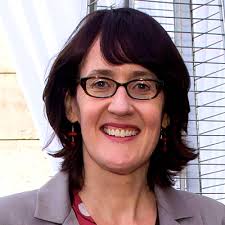
Fuller holds a Bachelor of Arts (Honours) in Economics and Political Studies from Queen’s University, and a Master of Science with distinction from the London School of Economics.
“Climate change is a global challenge that requires a global solution,” Trudeau said in a statement.” Everywhere, we are seeing the effects of climate change reminding us of the need to act now. Canada’s new Ambassador for Climate Change, Ms. Fuller, is here to lead Canada’s efforts and work in collaboration with the global community to tackle climate change and promote clean economic growth.”
“I’m very pleased to welcome Patricia Fuller as Canada’s new Ambassador for Climate Change,” said Catherine McKenna, Minister of Environment and Climate Change, in a statement.” Canada is proud to work with our international partners to advance climate solutions like phasing out coal, reducing risks from extreme weather and climate impacts, and supporting clean solutions and innovation. We’re all in this together, and international collaboration is essential to make sure we are leaving a healthy environment and a strong economy to our kids and grandkids.”
The Climate Change Ambassador has a key role in government-wide engagement on climate change and in the implementation of Canada’s clean growth and climate change priorities. Continued leadership and global cooperation are key to moving forward and meeting the Paris Agreement commitment to limit global temperature increases and to increase the ability to adapt to adverse impacts of climate change. To that effect, in December 2016, Canada released the Pan-Canadian Framework on Clean Growth and Climate Change to reduce greenhouse gas emissions and enable sustainable economic growth.
In 2014, Canada’s clean and sustainable technology industry employed over 55,600 people in almost 800 technology companies in all regions of the country. Most of these companies are small and medium-sized enterprises. Total revenues from this industry reached nearly $12 billion.
Canada has committed $2.65 billion to international climate finance to support a wide range of programs and initiatives that will help developing countries mitigate and build resilience to the impacts of climate change, deploy clean energy technology, and manage natural resources sustainably.
Pitching for a Weir for the Cowichan River [West Shore Voice News – as published April 27, 2018, page 2] Alistair MacGregor, MP supports local efforts to have the Cowichan Weir raised as “green infrastructure” on the Cowichan River. In the House of Commons this week he asked that the Dept of Oceans & Fisheries commit to funds for the project, to overcome critically low river flow rates due to climate change. Slow-moving water with higher temperatures poses a risk to fish and fish habitat. Holding back more lake water will ensure an adequate supply of water flow in summer months.
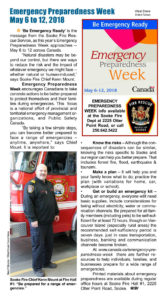 Be Prepared for 7 days. Article for Emergency Preparedness Week – Sooke Fire Rescue Service. As first published on page 3 in the April 27, 2018 print/PDF issue of West Shore Voice News.
Be Prepared for 7 days. Article for Emergency Preparedness Week – Sooke Fire Rescue Service. As first published on page 3 in the April 27, 2018 print/PDF issue of West Shore Voice News.
BC Government seeks public input about Agricultural Land Commission & Agriculture Land Reserve – April 20, 2018 – West Shore Voice News
Free soil testing for contaminants in the West Shore (participation deadline extended) – April 6, 2018 – by Mary P Brooke, West Shore Voice News
Soil contaminant testing offered to food growing households in the west shore – March 9, 2018 – by Sophia Romanchuk for West Shore Voice News




